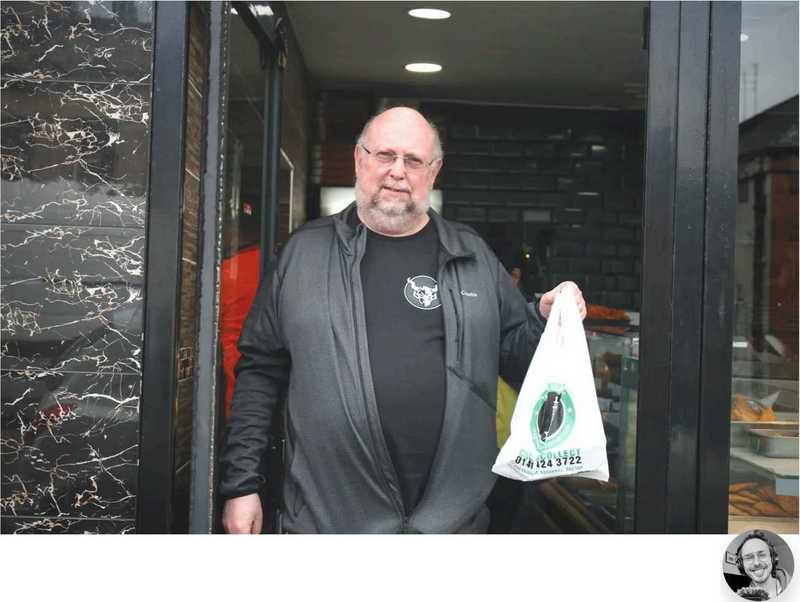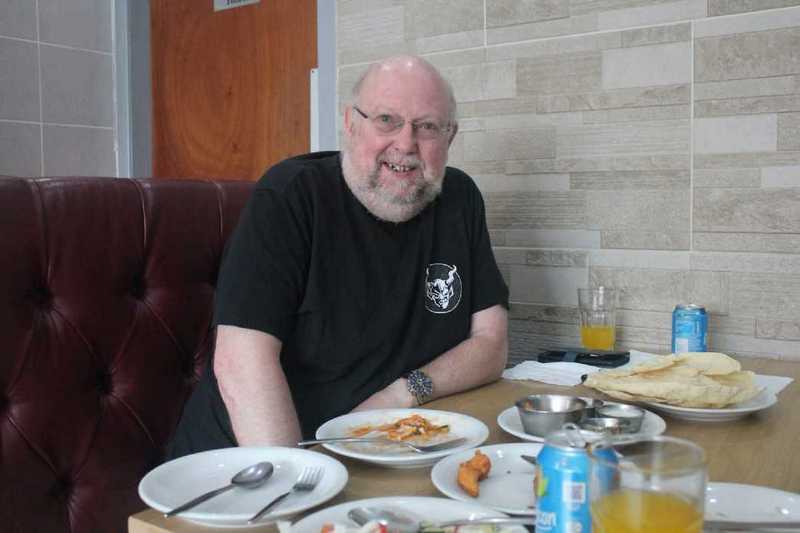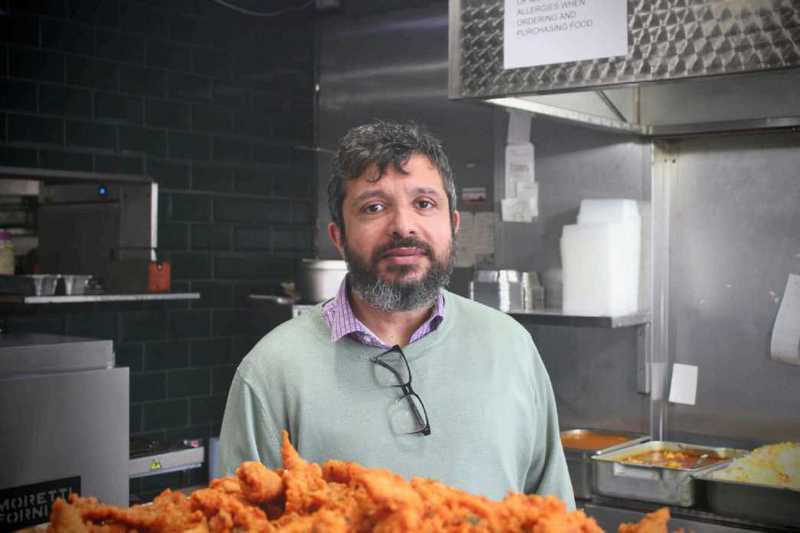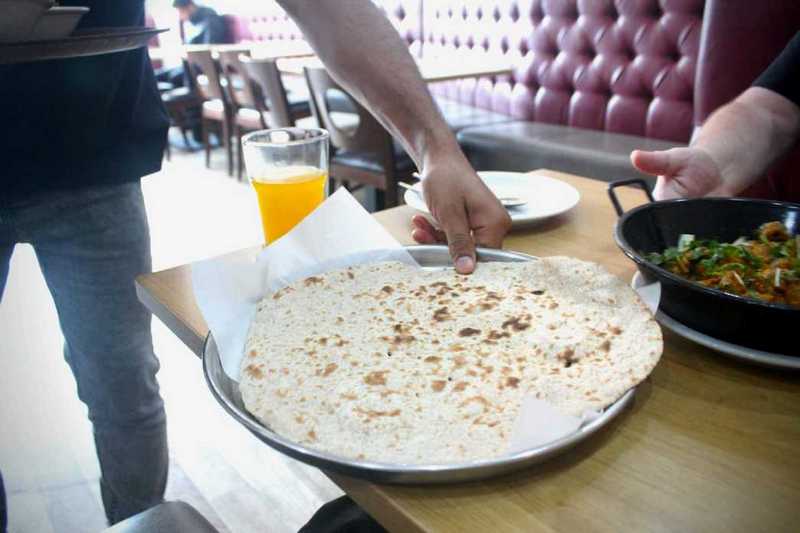Is this Glasgow’s — nay the world’s — most prolific curry critic?
Curry-Heute has reviewed over a thousand curries across the city — here are his favourites
ROBBIE ARMSTRONG | 27 August 2025 |
 It is impossible to convey the scope of Hector’s appetite for curry, but allow me to endeavour. Hector (not his real name) styles himself as “near mythical”, promising to all that, “If you cook Curry, Hector will visit, eat and review”. And review he has, on a scale that makes Jay Rayner’s career look a bit half-arsed, quite frankly.
It is impossible to convey the scope of Hector’s appetite for curry, but allow me to endeavour. Hector (not his real name) styles himself as “near mythical”, promising to all that, “If you cook Curry, Hector will visit, eat and review”. And review he has, on a scale that makes Jay Rayner’s career look a bit half-arsed, quite frankly.
Since Curry-Heute began in 2010, Hector has filed over a thousand reviews in Glasgow alone. Across Scotland, he’s totted up 1,284 entries. And he does not consign himself to his own patch. Hector has sampled rogan josh in Orkney, lamb Karahi in Caithness and onion bhaji in Inverness. In England, he’s eaten in the hallowed cities of Bradford (151 reviews), Birmingham (4) and Manchester (150), as well as further flung and lesser known locations like Huddersfield, Leamington Spa and Horsham. There are 44 entries for Crawley alone. He’s enjoyed aloo gobi in St Albans, sag duck in Berwick-upon-Tweed and mixed kebab in Peterborough (the less said about the latter, the better). In Germany, he’s clocked up 227 reviews — which may have something to do with Hector’s predilection for all things Germanic lager. But there are also entries for Ireland, Wales, Portugal, Spain, France, Belgium, the Netherlands, Italy, Luxembourg, Croatia, Malta, Czechia and Slovakia. (The list goes on). He’s eaten goat curry in Vermont: “I couldn’t believe how good it was”. Vegas, one word: “terrible”. Desi Korma in Albany: “A happy end to that trip.”
Last year, he went on a curry world tour, visiting Singapore, Australia, New Zealand, Canada and the United States. His first stop upon his return? Yadgar Kebab House on Calder Street, where we’re meeting today. It will be his 156th review of the Pakistani diner in Govanhill. It is the epitome of the “curry café’; the high watermark of desi cooking and the precise sweetspot in the price/quality curry ratio. (Others might describe Yadgar as a prime example of Humble Yum™). The café curry is Hector’s preferred plate, rather than the more upscale eateries, today centred around Merchant City, with the notable exception of Mother India. There is a global list of Hector’s recommended curry houses on his website, including restaurants as far afield as Seattle, Tel Aviv and …
Helensburgh. He’ll always come back to Yadgar’s though. “It is unique what they achieve in this place.”

Hector’s a happy chappy. Photo: Robbie Armstrong
Hector could well be the most prolific reviewer of curries. I invite you to find anyone who has reviewed more curry houses than he. In fact, there is only one other food writer on these isles with an equally obsessive approach to reviewing; Andy Hayler is to Michelin star restaurants what Hector is to mom-and-pop curry shops. Hayler may have been to every three star restaurant in the world, but has he frequented each of Glasgow’s world-famous Pakistani curry cafés? I thought not. And I know which middle-aged man I’d prefer to be eating lunch with on a Tuesday afternoon. “Three o’clock is my preferred time to eat, I’m not a breakfast person,” he explains, as I take a seat in the booth across from him.
So strap in, hopefully not on an empty stomach, as we bring you Curry-Heute’s Ten Curry Commandments, as well as his top ten Glasgow curry houses. You can thank me later — I’ll be at Yadgar’s, watching the main man chow down on an alarmingly large portion of goshat Karahi, mango Rubicon in hand.
Hector, 69, is a retired geography teacher from the West of Scotland (hence wishing to remain relatively anonymous). He’s portly, with rimless glasses and a grey beard. He exudes a geeky cheekiness, and is never far from cracking his next joke. For the past decade and a half, he’s been reviewing a minimum of two curries every week, often more. He writes up a review of each meal, without exception.
Curry-Heute came about as a happy accident, borne out of his previous blog, Bier Traveller, the idea for which had been knocking around his head since the dawn of the internet. When Hector found himself writing about curry as much as beer while on his travels, he started Curry-Heute, meaning ‘curry today’ in German — a nod to a late friend’s blog called Bier Today (as in bier today, gone tomorrow; which seems sadly apt since his pal’s passing). Interestingly, Hector goes out drinking with Shawarma Police, another fanatical food blogger we’ve written about before. Yet Hector has never eaten a lamb wrap with Will, nor Will a lamb Karahi with Hector. “The twain never shall meet,” he quips. His disinterest in wraps is explained thusly: “Any idiot can grill meat; cooking a masala takes skill.”

The Curry-Heute pose, apparently. Photo: Robbie Armstrong
Sections on his website include: ‘Gone, but not forgotten’; ‘Hector’s lust for curry’; and, inexplicably, ‘Prog Rock Concert Reviews’. He also has a recipes section, and a long-running campaign to stop restaurateurs using peppers/capiscum, which he lambasts as “cheap, nothing but ballast… detract[ing] from the Flavours of what is Indian Food” (more on this anon). He has a whole list of other campaigns, including the extortionate price of chapati, use of red food dye, charging for poddadoms, and other similarly heinous crimes against curry. Lamb is, without any hesitation, his favourite. “Ain’t no such thing as a chicken curry,” he delights in telling me, before going on to expand on his theory of flavour absorption relating to various types of meat. If it wasn’t already abundantly apparent, he has opinions on everything curry-related. He emphatically declares that “there is no good fish Karahi in Glasgow”, and urges the piscivorous among you to travel to Munich for your fishy fix.
Shkoor, the hospitable face of Yadgar’s, who Hector describes as “a delight”, wanders over to say his hellos. Fifteen years ago, he handed “the Hector” a menu, “and the rest is history”. “His palate has varied over the years,” Shkoor explains of
Hector, “but he’s still a red meat eating carnivore.” The only change he’s noticed: “He’s discovered vegetables.” Shkoor says that former pupils of Hector’s make the pilgrimage to Calder Street, where they ask for whatever Hector’s order is, before explaining that he is their old school teacher.

Shkoor Anwar, who’s father owns Yadgar’s. Photo: Robbie Armstrong
Hector’s repeat reviews are heavily grouped around informal curry cafés like Yadgar’s. “I can’t go to Merchant City — it’s too expensive, and I’d have to tell them it’s not worth the money … When you’re suddenly paying £23 for a main that you can pay a third for south of the river, why, what’s the point?” he asks. “I’m a pensioner, I can’t afford it.” One of his favourite places to eat is a takeaway with two tables and no toilet. Customers are sent to the bookies next door to use the facilities.
If an eatery in Glasgow only has one entry on his blog, as many do, one can assume that the food was either substandard, not to his exacting taste, too expensive, or a combination of the aforementioned. Take it all with a pinch of garam masala though; scanning the list, I notice numerous spots with a (1), (2) or (3) beside their names where I have enjoyed great (and occasionally exceptional) food. But I don’t make the rules.
We move on to the topic of Glasgow winning curry capital (it last won in 2010, a record fourth win in a decade). “Yes it deserved it, for the cafés. But when you see all the awards for the best places for Glasgow curry, they’re not the places I’m recommending.” There is likely no restaurant nor chef that could dissuade Hector that some of the best value for money curries this side of Karahi can be found in the ‘curry quarter’ of Govanhill, comprising Yadgar’s, Sheerin Palace, Darbar and Shahi Mahal. “I’d love to live around here, but I’d be twice the size I am now,” he says with a shake of the head. Hector’s favourite spots tend to make ‘desi’ or home-style curries with meat on-the-bone, preferably the day before, so the flavours have time to properly marinate. He has his own parameters for what makes a curry desi, which may seem odd for a white man from Glasgow — but seeing him speak with Shkoor and the rest of Yadgar’s staff over the course of a few hours, one quickly realises that he has nothing but the deepest of respect for culinary tradition and craft.
He refuses to rate or score curries (“If it’s curry, I’m going to enjoy it”), preferring to let the nuance of each review, and the number of repeat visits, to do the talking instead. He doesn’t make money from his blog, and (like Hayler) pays for food out of his own pocket.
Hector talks often and amiably of his wife, ‘Marg’, who features prominently in his reviews, often photographed over a cluttered table of curries with a wide smile. A number of her recipes also feature on his blog. (When I tell him about a friend’s family recipes from the Punjab, he immediately asks for copies). Does Marg like curry, I ask. “She does now,” he says with a belly laugh. Before they met, she was a “chicken curry sort of person”. These days, she’s seen the light, and knows lamb is best.

Yadgar’s roti and goshat Karahi. Photo: Robbie Armstrong
In 1964, when Hector was about eight or nine years old, his father, a master mariner, returned home one day with a recipe for an Indian curry from one of the ship’s crew. Hector’s mum was “duly dispatched to find the ingredients”. Hector tried the curry, which was far too spicy for his liking, so much so he “cried his eyes out”. His parents were indifferent, telling him, “This is your dinner, eat it.” The next time — with his father back at sea captaining his ship — his mother repeated the recipe, only milder. So his love for curry was born. His first visit to a curry house was in 1968, aged 11 or 12, at the Green Gates on Bank Street in the West End, one of the city’s first curry houses. He asked for the vindaloo. The waiter looked at him, then at his dad, who said “go for it”. It was “uncompromising and HOT!” as he describes on his blog. With time, he came to realise that spice alone is not the marker of a great curry. But he still remembers the taste. He begins to gesticulate with his hands, his eyes alight. “It was greeny brown, fierce, and unlike anything my mum had cooked.”
By his late teens, a student at university, he would visit Akbar off George Square on Cochrane Street on the regular (mid afternoon, then as now). Often, he would
head home for another curry that evening with his mum. Based on that one recipe from his father’s shipmate, his mother would go on to cook curry for the rest of her life. For their honeymoon, he and Marg went to Sri Lanka, where Hector attempted to eat three curries a day, before notching down to two for the seventeen-day duration of their trip. When he retired in 2016, he took a nine day trip to India, the results of which were recorded exhaustively. 20 years ago, he did a curry course at Anniesland college, where a Punjabi mother and daughter taught him all the basics. It is their recipes he has tweaked and adapted on his website.
Hector lives and breathes curry. He even has a list of “curry connections” in his address book. He gets out his phone, and shows me a long list of friends and acquaintances from across the country, their names prefixed with the word “Curry”. His reviews are even plastered on the walls of a Seattle curry house he visited with Marg. When I ask if he follows other food reviewers or critics, he smiles and says simply, “I eat curry.” On ceremonial occasions, he goes to Swadish, the acclaimed Indian restaurant by Indian chef and Great British Menu finalist Ajay Kumar. His only aversion appears to be to the “soupy curries” of Nepal, which he holds in contempt. By comparison, he takes his fork and compares it to the thick, ghee-rich sauce of Yadgar’s curries. He proceeds to point out the eight to ten pieces of lamb in the sauce, “a half kilo, which you couldn’t buy for less than £20 in a restaurant”. During the pandemic, Shkoor texted him to say, “Curry’s on the way.” Half an hour later, a kilo of lamb curry arrived at his door by delivery.

With friends like these … who needs shawarma? Photo: Robbie Armstrong
In the early days of Curry-Heute, there were two other curry reviewers in the city. “One got married, that put the kaibosh on it. The other petered out.” People have occasionally got in touch with him over the years to tell him they’re going to eat and review a curry every day, but they always fail to go the distance.
Shkoor comes back out to check on us. “There was a time when your capacity was way beyond current levels,” he tells Hector, before boxing up the remains of his lamb. “I’m ten kilos heavier than I was at the start of Covid and I eat less ,” Hector replies, patting his belly. “So all the conspiracy theories about the vaccine are true then,” Shkoor says with a laugh.
Hector’s Glasgow top ten
“I hate to promote the big guys, they don’t need me. I like to promote the little guys.”
Hector’s Ten Curry Commandments
The gospel according to Curry-Heute
-
Curry cannot be bland, nor should it cause discomfort. Optimally, a Masala should be medium, with a kick. Let’s not suffocate the flavours with extreme Chilli.
-
The spice and herb content should be revealed to their fullest: karrah – salt enhances the flavour. Seasoning, therefore, is all.
-
Apart from the surface, Chicken is non-absorbent, leading to the conclusion that there is no such thing as a Chicken Curry – yet it prevails globally. Try Lamb/Goat (Gosht), preferably on-the-bone, Fish (Machi), Venison (Hirn), the humble Potato (Aloo), these absorb Flavour and so can give it back.
-
Capsicum is ballast, creating the illusion of more on the plate. The afterglow is also unwelcome, burp. Peppers: green, red, yellow should be nowhere near a Curry, especially a Karahi. Karahi highlighting Peppers and Onions is a stir-fry, not authentic – avoid.
-
Food colouring, unnecessary, throw it in the bin, along with the Capsicum.
-
Curry is not Soup i.e. Meat swimming in a Masala, get the balance right. Bhuna is dry, make it so. Shorva does translate as Soup, a specific style of Masala served with Kofta, Nihari, Aloo Gosht.
-
There is genuine, home-style, Desi/Apna Curry served across the land, give it a go. Mainstream Curry Houses should not therefore simply add – Desi – to their menu and con the public.
-
Bread is made from flour and water, not gold dust, so charge an honourable sum. The traditional Bradford Curry Houses still serve three Chapattis with every Curry.
-
Outside the UK, Rice is included in the order. In Europe, served in portions which are enough to feed a family. Universally, common sense portions and pricing please.
-
Hot plates, hot food, not too much to ask.

One thing totally NOT mentioned in this piece is the readers (presumably) from all over the world.
Hector replies:
True!